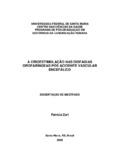| dc.creator | Zart, Patrícia | |
| dc.date.accessioned | 2008-09-29 | |
| dc.date.available | 2008-09-29 | |
| dc.date.issued | 2008-07-11 | |
| dc.identifier.citation | ZART, Patrícia. Cryostimulation in the oropharyngeal dysphagia after stroke. 2008. 113 f. Dissertação (Mestrado em Fonoaudiologia) - Universidade Federal de Santa Maria, Santa Maria, 2008. | por |
| dc.identifier.uri | http://repositorio.ufsm.br/handle/1/6438 | |
| dc.description.abstract | The purpose of this study was to check the effect of cryostimulation in the oropharyngeal sensitivity and afterward in the swallowing reaction and premature
escape of food in patients with neurogenic dysphagia after stroke.To select the patients of this research, the following procedures were made: record analysis,
interview with the patient and family, speech evaluation of the neurogenic dysphagia in hospital beds and videofluoroscopy test. At the end of the selection, seven adults subjects of both sex were envolved in this study, six men and one woman, with age ranging from 28 to 64, all of them with stroke, without other pathology of base and
with oropharyngeal dysphagia. After the selected patients had been passed by the procedures above described and been in accordance with the criteria of inclusion and exlcusion estabilished by the research, they were submitted to the
cryostimulation technique. The technique was made three times a day, during four days in a row, an overall of thirty daily applications for each structure ( anterior
faucial pillar, posterior oropharyngeal wall, soft palate and back tongue). Next the technique application, the patients were evaluated again following the same criteria.
There was a described analysis of data before and after cryostimulation of the clinic evaluation ranges and of the videofluoroscopy test. The data referring to time
measurements of total swallowing time, oral transit time up to the swallowing reaction and pharynx transit time of swallowing reaction up to the pharinx cleaning were also analized and were compared, before and after cryostimulation. To compare the results of before and after cryostimulation and obtain significant factor, the test t-student was used and the Fisher test, with significance 5% (p<0,05). The results showed that the cryostimulation was effective in the oropharinx sensitivity
recuperation in six of the seven subjects, with statistic significance. Also there were significant improvements, statistically speaking, in the improvement of swallowing
reaction and in the premature escape in six subjects. Therefore, the subjects showed an improvement in the aspects proposed by the objectives of this study after
the cryostimulation, and these results can be seen as in the speech evaluation as in the videofluoroscopy test. | eng |
| dc.format | application/pdf | por |
| dc.language | por | por |
| dc.publisher | Universidade Federal de Santa Maria | por |
| dc.rights | Acesso Aberto | por |
| dc.subject | Disfagia | por |
| dc.subject | Sensibilidade orofaríngea | por |
| dc.subject | Crioestimulação | por |
| dc.subject | Dysphagia | eng |
| dc.subject | Oropharyngeal sensitivity | eng |
| dc.subject | Cryostimulation | eng |
| dc.title | A crioestimulação nas disfagias orofaríngeas pós acidente vascular encefálico | por |
| dc.title.alternative | Cryostimulation in the oropharyngeal dysphagia after stroke | eng |
| dc.type | Dissertação | por |
| dc.description.resumo | Esta pesquisa teve como objetivos verificar o efeito da crioestimulação na sensibilidade orofaríngea, na reação de deglutição e escape prematuro de alimentos
em pacientes com disfagia neurogênica após acidente vascular encefálico (AVE). Para selecionar os pacientes da pesquisa, foram realizados os seguintes procedimentos: análise do prontuário, anamnese, avaliação fonoaudiológica das disfagias neurogênicas em leito hospitalar e exame de videofluoroscopia. Ao final da seleção, participaram deste estudo sete sujeitos adultos de ambos os sexos, sendo
seis homens e uma mulher, com idades variando entre 28 a 64 anos, todos com diagnóstico de AVE, sem outra patologia de base e tendo como conseqüência disfagia orofaríngea. Depois dos pacientes selecionados terem passado pelos
procedimentos acima descritos e estarem em conformidade com os critérios de inclusão e exclusão estabelecidos pela pesquisa, estes foram submetidos à técnica da crioestimulação. A técnica foi realizada três vezes ao dia, durante quatro dias seguidos totalizando trinta aplicações diárias para cada estrutura (pilares fauceais, parede posterior da orofaringe, palato mole e dorso da língua). Após a aplicação da técnica os pacientes foram reavaliados seguindo os mesmos critérios. Foi realizada análise descritiva dos dados pré e pós crioestimulação das variáveis da avaliação
clínica e do exame de videofluoroscopia. Os dados referentes às medidas de tempo dos aspectos de tempo total de deglutição, tempo de trânsito oral até a reação de
deglutição e tempo de trânsito faríngeo, da reação de deglutição até a limpeza faríngea também foram analisados e comparados, pré e pós crioestimulação. Para comparar os resultados pré e pós crioestimulação e obter fator de significância, utilizaram-se o teste t-student e o teste Fisher, com significância 5% (p<0,05). Os resultados mostraram que a crioestimulação foi efetiva na recuperação da
sensibilidade orofaríngea em seis dos sete sujeitos, com significância estatística. Também se observaram melhoras estatisticamente significativas na reação de deglutição e no escape prematuro em seis sujeitos. Portanto, os sujeitos
apresentaram melhora nos aspectos propostos pelos objetivos deste estudo após a crioestimulação, resultados estes visualizados tanto na avaliação fonoaudiológica
como na avaliação videofluoroscópica. | por |
| dc.contributor.advisor1 | Silva, Ana Maria Toniolo da | |
| dc.contributor.advisor1Lattes | http://lattes.cnpq.br/3609781201156265 | por |
| dc.contributor.referee1 | Castro, Simone Augusta Finard de Nisa e | |
| dc.contributor.referee1Lattes | http://lattes.cnpq.br/5118618074403585 | por |
| dc.contributor.referee2 | Weinmann, Angela Regina Maciel | |
| dc.contributor.referee2Lattes | http://lattes.cnpq.br/9151119377173425 | por |
| dc.creator.Lattes | http://lattes.cnpq.br/3380793894564560 | por |
| dc.publisher.country | BR | por |
| dc.publisher.department | Fonoaudiologia | por |
| dc.publisher.initials | UFSM | por |
| dc.publisher.program | Programa de Pós-Graduação em Distúrbios da Comunicação Humana | por |
| dc.subject.cnpq | CNPQ::CIENCIAS DA SAUDE::FONOAUDIOLOGIA | por |


